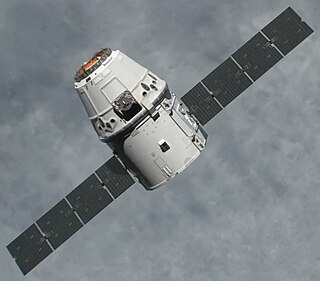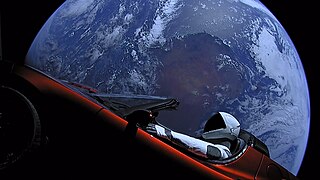Related Research Articles
The Space Test Program (STP) is the primary provider of spaceflight for the United States Department of Defense (DoD) space science and technology community. STP is managed by a group within the Advanced Systems and Development Directorate, a directorate of the Space and Missile Systems Center of the United States Space Force. STP provides spaceflight via the International Space Station (ISS), piggybacks, secondary payloads and dedicated launch services.

The year 2012 saw a number of significant events in spaceflight. In May and October, the first Commercial Orbital Transportation Services resupply missions took place, during which the SpaceX Dragon became the first private spacecraft to dock with the International Space Station (ISS). In June, China launched the crewed Shenzhou 9 orbital mission, and North Korea achieved its first successful orbital launch in December. 2012 also saw China's first successful asteroid exploration mission, and the landing of NASA's Curiosity rover on Mars. The Vega and Unha-3 rockets made their maiden flights in 2012, while the Proton-K made its last.

Kedr, also known as ARISSat 1 and RadioSkaf-2, was an amateur radio minisatellite operated by RKK Energia as part of the Amateur Radio on the International Space Station and RadioSkaf programmes. A follow-up to the SuitSat spacecraft, Kedr was launched to commemorate the fiftieth anniversary of the Vostok 1 mission.
The Geo-IK-2 is a Russian series of new generation military geodesy satellites replacing the Soviet Union's Geo-IK and Sfera constellations. They are intended to be used to create high precision three-dimensional maps of the Earth's surface, and to monitor plate tectonics. The satellites are produced by ISS Reshetnev, and have a mass of around 1,400 kilograms (3,100 lb). They operate in a circular orbit at an altitude of around 1,000 kilometres (620 mi) above the Earth's surface.

In 2014, the maiden flight of the Angara A5, Antares 120 and Antares 130 took place.

Several new rockets and spaceports began operations in 2016.

This article documents notable spaceflight events during the year 2019.

Notable spaceflight activities in 2017 included the maiden orbital flight of India's Geosynchronous Satellite Launch Vehicle Mark III on 5 June and the first suborbital test of Rocket Lab's Electron rocket, inaugurating the Mahia spaceport in New Zealand. The rocket is named for its innovative Rutherford engine which feeds propellants via battery-powered electric motors instead of the usual gas generator and turbopumps.

This article documents notable spaceflight events during the year 2018. For the first time since 1990, more than 100 orbital launches were performed globally.
Technology Education Satellite (TechEdSat) is a successful nano-sat flight series conducted from the NASA Ames Research Center in collaboration with numerous universities. While one of the principal aims has been to introduce young professionals and university students to the practical realm of developing space flight hardware, considerable innovations have been introduced. In addition, this evolving flight platform has tested concepts for Low Earth Orbit (LEO) sample return, as well as planetary nano-sat class mission concepts.

Planet Labs PBC is a publicly held American Earth imaging company based in San Francisco, California. Their goal is to image the entirety of the Earth daily to monitor changes and pinpoint trends.
The Lincoln Calibration Sphere 1, or LCS-1, is a large aluminium sphere in Earth orbit since 6 May 1965. It is still in use, having lasted for over 50 years. The sphere was launched along with the Lincoln Experimental Satellite-2 on a Titan IIIA. It is technically the oldest operational spacecraft, but it has no power supply or fuel; it is merely a passive metal sphere. LCS-1 has been used for radar calibration since its launch. It was built by Rohr. Corp. for the MIT Lincoln Laboratory.

Progress MS-01, identified by NASA as Progress 62P was a Progress spaceflight operated by Roscosmos to resupply the International Space Station (ISS) in 2015. It was launched on 21 December 2015, to deliver cargo to the ISS. Progress MS-01 is the first vehicle in the Progress-MS series.

Progress MS-12, Russian production No.442, identified by NASA as Progress 73P, was a Progress spaceflight operated by Roscosmos to resupply the International Space Station (ISS). This was the 164th flight of a Progress spacecraft.

The KAUR program was a series of satellite buses designed and manufactured by ISS Reshetnev. Its design is based on a pressurized bus originally developed in the 1960s and has been used from low Earth Orbit to medium Earth orbit and even to GEO. It has four different generations and its different versions have been used from civilian communications to satellite navigation.

Sfera is a series of Soviet geodetic satellites.

Progress MS-15, Russian production No. 444, identified by NASA as Progress 76P, was a Progress spaceflight operated by Roscosmos to resupply the International Space Station (ISS). This was the 167th flight of a Progress spacecraft.
References
- ↑ Krebs, Gunter D. "Sfera-53 (TEKh-44, Vektor-T)". Gunter's Space Page. Retrieved 5 May 2023.
- ↑ "What a ball-shaped Sfera satellite looks like". esa.int. 20 August 2012. Retrieved 5 May 2023.
- ↑ ISS Exp. 32 - Russian EVA-31 Updates Archived 2013-12-25 at the Wayback Machine
- ↑ SFERA